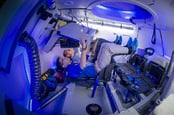This article is more than 1 year old
This isn't Boeing very well... Faulty timer knackers Starliner cargo capsule on its way to International Space Station
What a clock-up
Boeing’s first attempt to get its Starliner capsule to dock with the International Space Station has failed due to a software blunder. The unit was carrying cargo to the orbiting science lab though Boeing hopes to use it to send people into the obsidian void at some point.
This particular Starliner mission took off on Friday morning from Cape Canaveral Air Force Station, on the US East Coast, at 06:36:43 EST (11:36:43 UTC) atop a United Launch Alliance Atlas V rocket. Everything looked hunky-dory for a while, then 31 minutes into the flight things started to go very wrong.
The spacecraft was supposed to fire its main engine to line it up with the ISS in what’s called an orbit insertion burn. However, before that maneuver was due to begin, a malfunction in the Starliner’s Mission Event Timer clock caused the control software to think the main rocket firing was already underway.
The engine wasn't firing, though, and the capsule wasn't lining up as expected with the space station, causing the on-board computer to waste its thruster fuel fruitlessly adjusting its position while still some considerable distance from the orbiting platform. It needed that fuel to dock with the station when close by, so by burning it all so early, the mission was a failure. Even if the main engine fired, the Starliner wouldn't be able to maneuver itself into place on arrival.
Boeing engineers tried to establish control of the spacecraft to correct its orbit, but they were too late: the fuel was gone. It’s not all bad news, though: the Starliner is still in a stable orbit and won’t burn up. However, it’s highly embarrassing for Boeing’s already delayed attempt to get its machinery cleared for use by NASA.
The eight-day mission has now been cut short, and NASA and Boeing have said the thing will stay in orbit for 48 hours. During that time they will do what testing they can on the Starliner’s systems and will make a deorbit burn with the goal of landing at the White Sands Missile Range in New Mexico, USA, on Sunday.
The mission isn’t a total failure and, had crew been on board, they could have taken manual control and fixed the issue. But the lack of docking and several other maneuvers will mean the Starliner will almost certainly have to make another attempt at reaching the ISS. Elon Musk was on hand to offer advice.
Orbit is hard. Best wishes for landing & swift recovery to next mission.
— Elon Musk (@elonmusk) December 20, 2019
Also spare a thought for the space-station crew. The Starliner was apparently carrying their Christmas presents, and unless Santa gets orbital capability, they’ll have a barren Yuletide morning. ®

